
Station Name: CHEVINGTON[Source: Alan Young]
Chevington Station Station Gallery 1: c1906 - February 1991 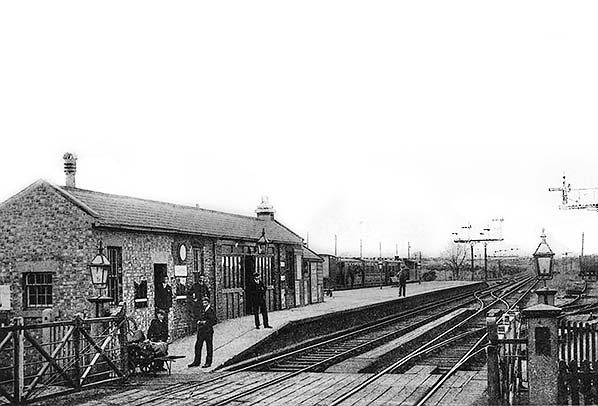 Looking north from the level crossing at the down main line and bay platforms at Chevington c1906. An Amble branch passenger train is standing in the bay platform. The single-storey brick building on the left contain booking and waiting facilities, and the several men in the foreground are probably station staff. Handsome NER casement oil lamps adorn the crossing, the building and the platform.
Photo from Alan Young collection  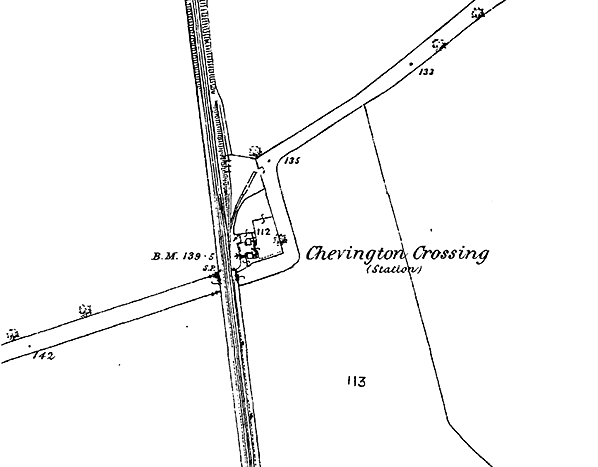 1859 1:2,500 OS map. The cottages built for the crossing keepers, north of the level crossing and east of the double-track railway, are shown, but ‘Station’ seems to be a late addition to ‘Chevington Crossing’ without the representation of platforms or passenger buildings. There is no evidence that the station was ever called ‘Chevington Crossing’. A short siding to a goods dock extends north-east of the station.
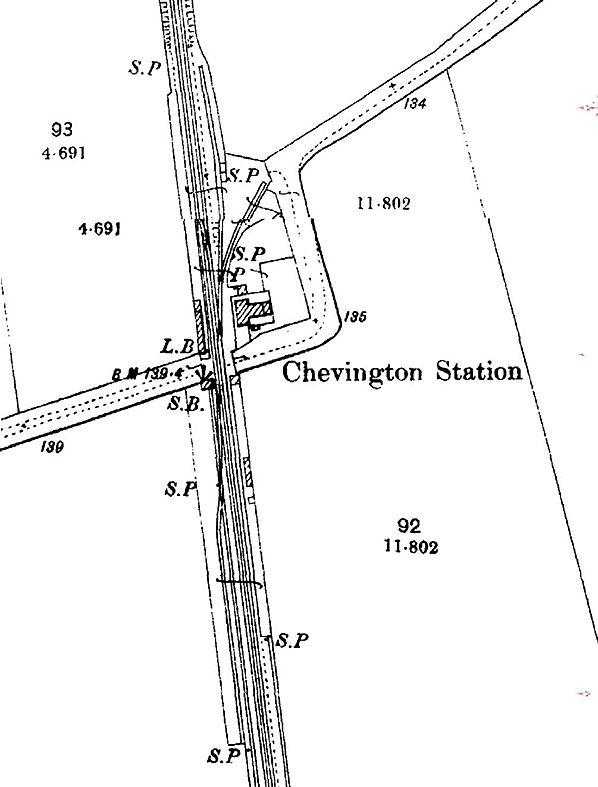 1897 1: 2,500 OS map. The station is now shown. The crossing cottages, east of the tracks, now face a platform on the west (down) side which has a building immediately north of the level crossing. The up platform is south of the crossing, with a building midway along it. A signal box, opened by October 1877, is immediately south of the crossing, west of the tracks. Two sidings have been added on the down side, south of the crossing. A further railway track extends from the southern ramp of the up platform for several hundred yards with no connection to the main line. It is assumed that this was provided in association with the ‘Old Colliery Railway’ branch which extended to an abandoned coal shaft on West Chevington Farm. A 40ft shaft was sunk here sometime between 1860 and 1890, but only one workable coal seam was found, so a further bore of about 100ft was sunk from the bottom of this shaft. The working appears to have been abandoned as no coal was commercially extracted – and the failed colliery was apparently never given a name. It is understood that the short branch railway was built, but it was lifted when the coal shaft was abandoned. The area east of the shaft was later exploited as West Chevington Opencast in the 1980s, and later extended and deepened as Stobswood Opencast. The north-to-east chord of the original colliery railway – or a route very close to it - appears to have been used later for access to Stobswood opencast site.
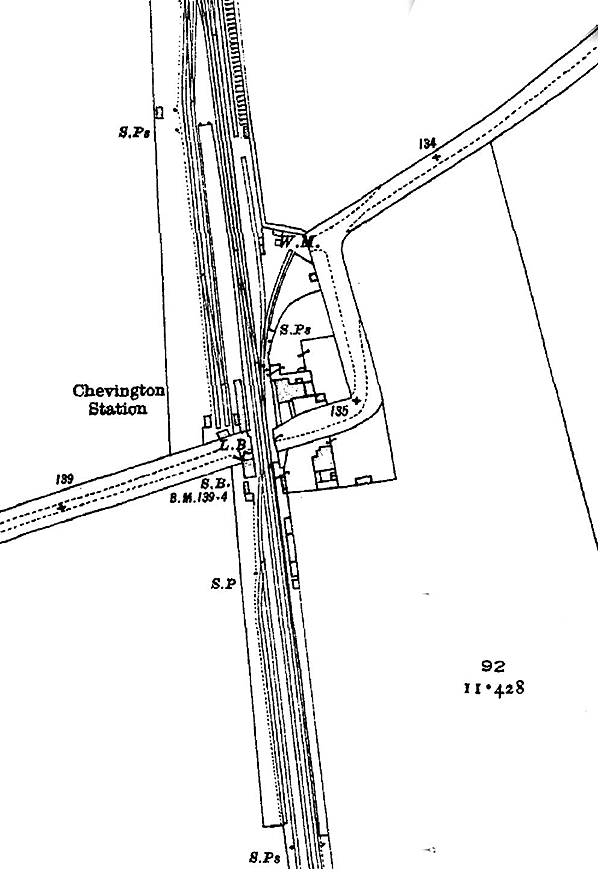 1923 1: 2,500 OS map. The surroundings of the station are still distinctly rural. Provision is made for Amble branch trains to use Chevington as their terminus, as two tracks have been added to the west of the down platform; the rear of the platform is now a ‘bay’. The building on the up platform has been extended since 1897. A railway cottage has been built across the road from the original crossing cottages. 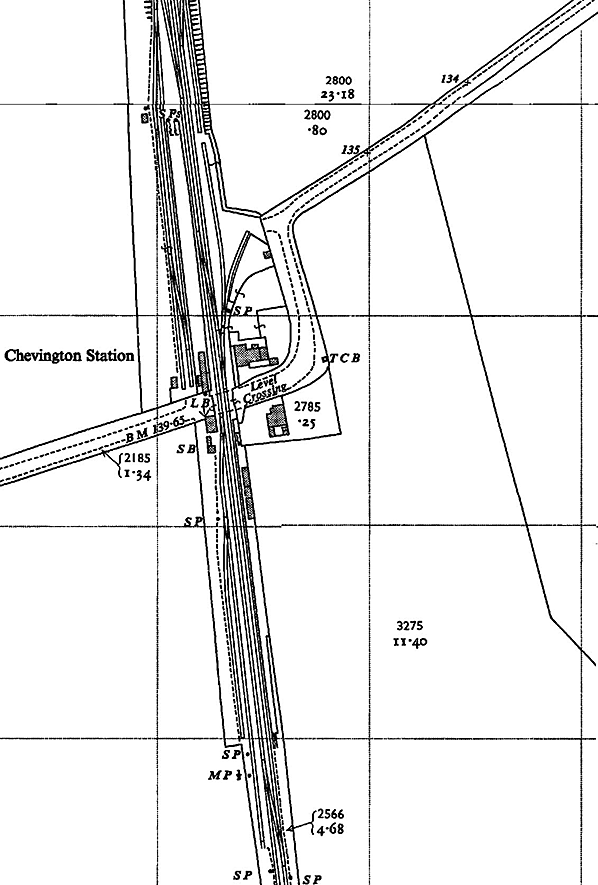 1959-60 1: 2,500 OS map. The station closed to passengers in 1958 but goods were handled until 1964, and the sidings for this traffic remain in place on this map.
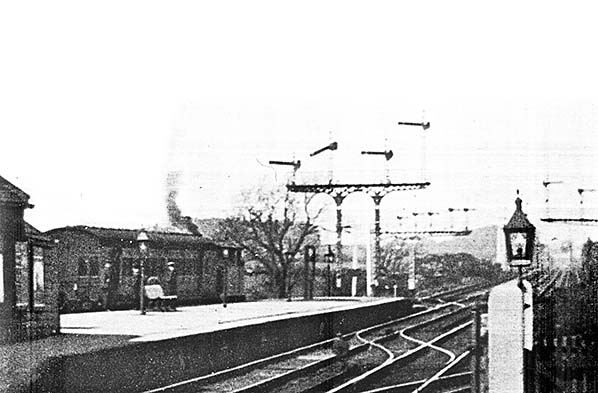 This view is looking north from the level crossing c1906; the dramatic curve of the cross-over railway track and apparent shortness of the platform suggest that a telescopic lens has been used on the camera. An Amble branch passenger train is seen at the bay platform. The down main line platform is in the foreground. The fine collection of semaphore signals will be noted.
old5.jpg) Looking north at Chevington station in this undated view a railwayman is preparing to cut a rail. The up platform is to the right, with nondescript single-storey buildings. The crossing cottages, also to the right, which pre-date the station by over 30 years, are beyond the crossing. The signal box is on the left and it obscures the down and bay platforms beyond the crossing/
Photo from John F Mallon collection / NERA old4.jpg) The up platform and signal box at Chevington are seen in October 1959, looking south from the level crossing, a little over a year after the station closed to passengers. At this time the station continues to handle goods traffic, and a loading gauge and sidings are still in place. The former crossing cottages and the down platform are behind the photographer.
Photo from John F Mallon / NERA old2.jpg) The up ‘North Briton’ express was derailed at Amble Junction, one mile north of Chevington station on 15 July 1967, as a result of which nine passengers were injured. A faulty rail was the
cause of the accident. Photo
from John Young collection from Railways of Berwick and the Eastern Borders
private Facebook group 4.jpg)
The former crossing cottages at Chevington on the up side of the East Coast main line tracks are seen from a passing train in September 1972.
Photo by Alan Young 8.jpg) The signal box at the former Chevington station to the west of the East Coast main line tracks, looking south-west from the level crossing in June 1978. This N2-design NER box with a stone base was opened by October 1977 and it closed on 24 February 1991. Photo by Keith Holt from the KDH Archive Click here for Chevington Station Station Gallery 2:
|
 Notes: Chevington was one of the locations on the Newcastle & Berwick Railway where crossing keepers’ accommodation, but no station, was provided when the line opened in 1847. The accommodation, at a location identified in N&B records as West Chevington, was of a standard design for the line comprising a pair of semidetached ‘chalet style’ dwellings with attic bedrooms lit by gabled windows; mullioned bay windows faced the railway with entrances between them. Despite the sparsely populated location, a passenger station opened here in October 1870, served initially by four weekday and two Sunday trains in each direction. It had staggered platforms, the down platform being north of the crossing, facing the original cottages, while the up platform was south of the crossing.
Notes: Chevington was one of the locations on the Newcastle & Berwick Railway where crossing keepers’ accommodation, but no station, was provided when the line opened in 1847. The accommodation, at a location identified in N&B records as West Chevington, was of a standard design for the line comprising a pair of semidetached ‘chalet style’ dwellings with attic bedrooms lit by gabled windows; mullioned bay windows faced the railway with entrances between them. Despite the sparsely populated location, a passenger station opened here in October 1870, served initially by four weekday and two Sunday trains in each direction. It had staggered platforms, the down platform being north of the crossing, facing the original cottages, while the up platform was south of the crossing. On 5 September 1849, a branch had opened from the main line a mile north of Chevington to serve the port of Amble from which coal was shipped to London and destinations in Germany and Scandinavia. The branch handled only mineral traffic until 1879. An NER working timetable of February 1879 indicates that a passenger service was introduced on the Amble branch, but other sources suggest that the date was June or July of that year. The branch passenger trains used a bay behind the down main line platform at Chevington as their terminus, and a dull, utilitarian single-storey brick building at the southern end of the platform provided booking and waiting facilities. The up platform had an equally undistinguished building. The signal box was constructed by October 1877 and placed immediately south of the level crossing on the down side. It was an NER N2 design with a stone base, originally with a 40-lever McKenzie & Holland frame, later extended to 43 then 56 levers. At Amble Junction the original signal box, constructed pre-1873, was replaced with a bridge-mounted type N5 cabin in 1900, equipped with a 62-level McKenzie & Holland frame. This box closed in the early 1930s.
On 5 September 1849, a branch had opened from the main line a mile north of Chevington to serve the port of Amble from which coal was shipped to London and destinations in Germany and Scandinavia. The branch handled only mineral traffic until 1879. An NER working timetable of February 1879 indicates that a passenger service was introduced on the Amble branch, but other sources suggest that the date was June or July of that year. The branch passenger trains used a bay behind the down main line platform at Chevington as their terminus, and a dull, utilitarian single-storey brick building at the southern end of the platform provided booking and waiting facilities. The up platform had an equally undistinguished building. The signal box was constructed by October 1877 and placed immediately south of the level crossing on the down side. It was an NER N2 design with a stone base, originally with a 40-lever McKenzie & Holland frame, later extended to 43 then 56 levers. At Amble Junction the original signal box, constructed pre-1873, was replaced with a bridge-mounted type N5 cabin in 1900, equipped with a 62-level McKenzie & Holland frame. This box closed in the early 1930s. Several sidings adjoined Chevington station, as indicated on a 1934 line diagram; two were south of the crossing, on the down side, entered from the north. To the north of the crossing, again on the down side, were two sidings entered from a loop – one serving the bay platform - and two more were on the up side, their entrance facing south. The RCH 1904 Handbook noted that Chevington could handle most types of goods traffic, and 1913 NER records show that livestock was the principal component, with 185 vans dealt with that year.
Several sidings adjoined Chevington station, as indicated on a 1934 line diagram; two were south of the crossing, on the down side, entered from the north. To the north of the crossing, again on the down side, were two sidings entered from a loop – one serving the bay platform - and two more were on the up side, their entrance facing south. The RCH 1904 Handbook noted that Chevington could handle most types of goods traffic, and 1913 NER records show that livestock was the principal component, with 185 vans dealt with that year. An accident occurred on 13 September 1913 south of Chevington station. The report of the incident states that the 11.45pm express from London to Edinburgh, consisting of an engine, tender and six coaches was running between Widdrington and Chevington stations when the train, with the exception of the engine, left the rails. Its speed at the time of the derailment was between 55 and 60mph. The vehicles of the train were derailed to the up side of the down line on which they were running, and the train became uncoupled at two points. No vehicles, however, were overturned, and none of the 21 passengers who were travelling in them were injured by the accident, though one sprained his ankle in alighting from his carriage.
An accident occurred on 13 September 1913 south of Chevington station. The report of the incident states that the 11.45pm express from London to Edinburgh, consisting of an engine, tender and six coaches was running between Widdrington and Chevington stations when the train, with the exception of the engine, left the rails. Its speed at the time of the derailment was between 55 and 60mph. The vehicles of the train were derailed to the up side of the down line on which they were running, and the train became uncoupled at two points. No vehicles, however, were overturned, and none of the 21 passengers who were travelling in them were injured by the accident, though one sprained his ankle in alighting from his carriage.
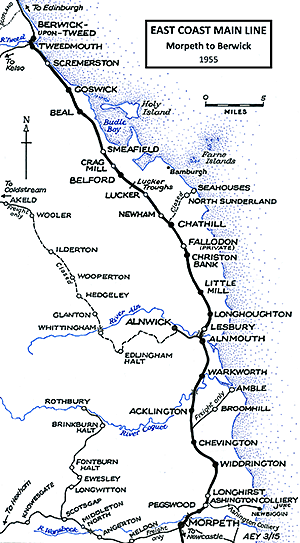 The station failed to attract any significant settlement in its vicinity; in 1911 only 888 people lived within its catchment and 8,584 tickets were issued. However the two stations on the Amble branch were much busier, with the terminus booking 31,806 passengers and Broomhill, the only intermediate station, booking 27,746 in 1911.
The station failed to attract any significant settlement in its vicinity; in 1911 only 888 people lived within its catchment and 8,584 tickets were issued. However the two stations on the Amble branch were much busier, with the terminus booking 31,806 passengers and Broomhill, the only intermediate station, booking 27,746 in 1911.  With the introduction of the summer 1952 timetable, in common with other minor ECML stations in Northumberland, the service frequency was reduced. Trains no longer called on Sunday from June 1955. The final timetable for Chevington consisted of two southbound weekday departures (three on Saturday) and two northbound (four on Saturday). Chevington, and several other stations between Newcastle and Berwick-upon-Tweed, closed to passengers on 15 September 1958. Goods traffic continued to be handled at Chevington until 10 August 1964. The branch stations at Broomhill and Amble also lost their goods services in 1964, the former on 4 May and the latter on 14 December. Coal traffic continued on the Amble branch, and parcels were handled at Amble station, until the line closed completely on 6 October 1969, and the tracks were lifted in 1972.
With the introduction of the summer 1952 timetable, in common with other minor ECML stations in Northumberland, the service frequency was reduced. Trains no longer called on Sunday from June 1955. The final timetable for Chevington consisted of two southbound weekday departures (three on Saturday) and two northbound (four on Saturday). Chevington, and several other stations between Newcastle and Berwick-upon-Tweed, closed to passengers on 15 September 1958. Goods traffic continued to be handled at Chevington until 10 August 1964. The branch stations at Broomhill and Amble also lost their goods services in 1964, the former on 4 May and the latter on 14 December. Coal traffic continued on the Amble branch, and parcels were handled at Amble station, until the line closed completely on 6 October 1969, and the tracks were lifted in 1972.
 Home Page
Home Page